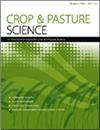Exploring the potential of rising plate meter techniques to analyse ecosystem services from multi-species grasslands
IF 1.9
4区 农林科学
Q2 AGRICULTURE, MULTIDISCIPLINARY
引用次数: 3
Abstract
ABSTRACT Context. Continuous grazing in extensive grassland creates grazed and ungrazed patches, which are important for ecosystem service delivery. One possibility for optimising ecosystem services is to target a defined compressed sward height, which can be measured with rising plate meters supplied with internal global navigation satellite system (GNSS) receivers. Aims. We assessed the ability of a modern rising plate meter to map long-term patch structure in extensively grazed grassland as a means to improve estimation of phytodiversity at paddock scale as a paramount ecosystem service. Methods. The patch class proportions obtained from interpolating the georeferenced compressed sward height values were used to calculate phytodiversity indicators at paddock scale as determined by dry-weight ranking. In addition, a modern rising plate meter with internal GNSS receiver was compared with an established one without GNSS receiver. Key results. The mapping of the patch classes revealed decreasing proportions of tall patches with increasing stocking intensity. Phytodiversity at paddock scale depended on the proportions of respective patches, highlighting the importance of accurate mapping of patches for ecosystem service assessment. Conclusions. The new rising plate meter extends the utilisation of compressed sward height measurements into a spatial context. Patch size, spatial distribution of patches within a paddock and spatial clustering of patches, as well as repeated mapping over time, can be utilised to detect change and monitor long-term management schemes without the need for sophisticated remote-sensing applications. Implications. The combination of the new rising plate meter and dry-weight ranking extends grazing management towards biodiversity monitoring in an easy-to-learn approach.探索上升板测量技术在多物种草原生态系统服务分析中的潜力
抽象的上下文。在广阔的草地上连续放牧会形成放牧斑块和未放牧斑块,这对提供生态系统服务很重要。优化生态系统服务的一种可能性是将一个确定的压缩草地高度作为目标,这可以用内置全球导航卫星系统(GNSS)接收器提供的上升板仪表来测量。目标我们评估了现代上升板仪在广泛放牧草地中绘制长期斑块结构的能力,以此作为一种手段来改善围场尺度上植物多样性的估计,这是一种重要的生态系统服务。方法。通过插值地理参考压缩草地高度值得到斑块类比例,并通过干重排序计算围场尺度上的植物多样性指标。此外,还将一种内置GNSS接收机的现代上升板仪表与一种不带GNSS接收机的现有上升板仪表进行了比较。关键的结果。随着放养强度的增加,高斑块的比例逐渐减少。围场尺度上的植物多样性取决于各斑块的比例,强调了斑块精确制图对生态系统服务评价的重要性。结论。新的上升板测量仪将压缩的剑高度测量扩展到空间环境中。斑块大小、围场内斑块的空间分布和斑块的空间聚类,以及一段时间内的重复测绘,可用于检测变化和监测长期管理方案,而无需复杂的遥感应用。的影响。新型上升板计与干重排序相结合,使放牧管理以易于学习的方式向生物多样性监测方向发展。
本文章由计算机程序翻译,如有差异,请以英文原文为准。
求助全文
约1分钟内获得全文
求助全文
来源期刊

Crop & Pasture Science
AGRICULTURE, MULTIDISCIPLINARY-
CiteScore
4.20
自引率
15.80%
发文量
111
审稿时长
3 months
期刊介绍:
Crop and Pasture Science (formerly known as Australian Journal of Agricultural Research) is an international journal publishing outcomes of strategic research in crop and pasture sciences and the sustainability of farming systems. The primary focus is broad-scale cereals, grain legumes, oilseeds and pastures. Articles are encouraged that advance understanding in plant-based agricultural systems through the use of well-defined and original aims designed to test a hypothesis, innovative and rigorous experimental design, and strong interpretation. The journal embraces experimental approaches from molecular level to whole systems, and the research must present novel findings and progress the science of agriculture.
Crop and Pasture Science is read by agricultural scientists and plant biologists, industry, administrators, policy-makers, and others with an interest in the challenges and opportunities facing world agricultural production.
Crop and Pasture Science is published with the endorsement of the Commonwealth Scientific and Industrial Research Organisation (CSIRO) and the Australian Academy of Science.
 求助内容:
求助内容: 应助结果提醒方式:
应助结果提醒方式:


